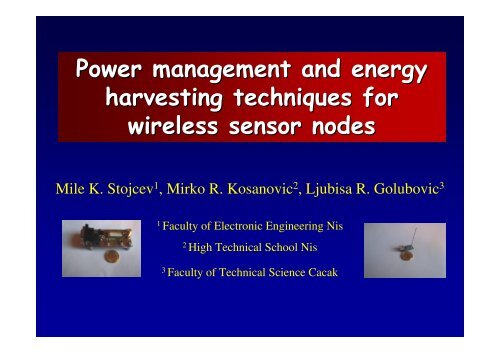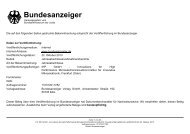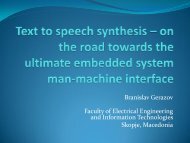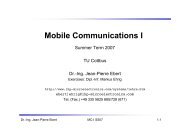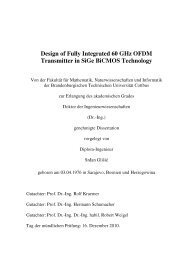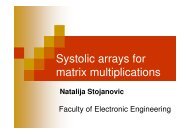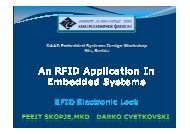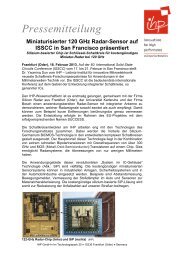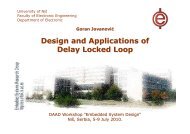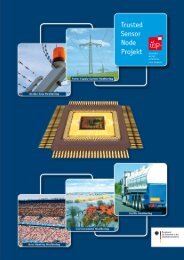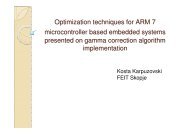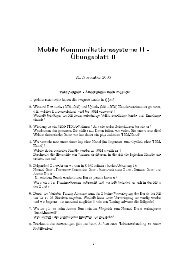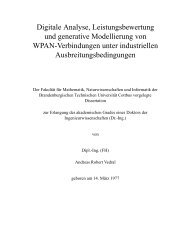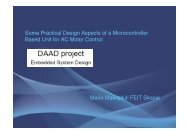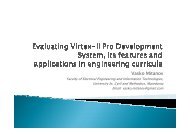Power management and energy harvesting techniques
Power management and energy harvesting techniques
Power management and energy harvesting techniques
Create successful ePaper yourself
Turn your PDF publications into a flip-book with our unique Google optimized e-Paper software.
<strong>Power</strong> <strong>management</strong> <strong>and</strong> <strong>energy</strong><br />
<strong>harvesting</strong> <strong>techniques</strong> for<br />
wireless sensor nodes<br />
Mile K. Stojcev 1 , Mirko R. Kosanovic 2 , Ljubisa R. Golubovic 3<br />
1<br />
Faculty of Electronic Engineering Nis<br />
2<br />
High Technical School Nis<br />
3<br />
Faculty of Technical Science Cacak
1. Introduction<br />
Outline<br />
2. System architecture of a sensor node<br />
- Computing subsystem - microcontroller<br />
- Communication subsystem - radio<br />
- Sensing subsystem<br />
- Low-power versus ultra-low-power sensor node design<br />
- Energy sources <strong>and</strong> Batteries issues<br />
3. Workload profile of sensor node<br />
4. <strong>Power</strong> <strong>management</strong><br />
- Techniques for power <strong>management</strong><br />
5. Sources of <strong>energy</strong> <strong>harvesting</strong><br />
6. Conclusion
Introduction<br />
- What is WSN -<br />
Wireless Sensor Networks, WSNs, are large networks composed of small<br />
sensor nodes, SNs, with limited computer resources capable for gathering,<br />
data processing <strong>and</strong> communicating.<br />
Collections of tiny, inexpensive wireless sensor nodes (modules), organized in<br />
clusters <strong>and</strong> networks deployed over a geographical area, capable to integrate<br />
continuous <strong>and</strong> unobtrusive measurement, computing <strong>and</strong> wireless<br />
communication.<br />
WSNs have attracted much attention during the last decade in forming the<br />
concept of smart spaces.<br />
1<br />
2<br />
3
Introduction<br />
- Challenges in realization of WSN -<br />
Challenges which relate to:<br />
– how to transmit data, <strong>and</strong><br />
– how to power the sensors<br />
are essential aspects in WSN design.<br />
Two main polices are carried out to save power:<br />
– radio transceiver is powered down when unused, <strong>and</strong><br />
– CPU is switched to a low power mode when no computation is<br />
required.
Introduction<br />
- Batteries -<br />
Batteries provide the most obvious power source of sensor nodes.<br />
In spite of the fact that battery technology is mature, extensively<br />
commercialized, <strong>and</strong> completely self-contained, even for relatively<br />
large battery capacity <strong>and</strong> moderate communication traffic<br />
requirements, the mean time to replacement or recharging is only two<br />
or three years.<br />
For deployment with hundreds of sensors, this means that a battery<br />
will need a replacement every few days, what represents an unsuitable<br />
rate for many applications.<br />
Panasonic<br />
CR2354<br />
560 mAh
Introduction<br />
- Example -<br />
In general, save a few micro watts is crucial to extend the operational mode<br />
of a SN for several years.<br />
A device with an average current consumption of 10 µA at 3V (30 µW),<br />
powered by a CR2450 lithium battery (nominal capacity 600 mAh), will<br />
have a theoretical operational life of 6 years.<br />
Saving just 2 µA (what means 20% or 6 µW less power), the SN`s<br />
operational mode will be extended two years <strong>and</strong> a half more.
Introduction<br />
- <strong>Power</strong> problems -<br />
Several solutions to the power problem exist:<br />
1. reducing power consumption<br />
to the point where batteries can<br />
elongate the sensor module’s<br />
lifetime,<br />
2. <strong>energy</strong> <strong>harvesting</strong>–EH<br />
(or <strong>energy</strong> scavenging) - that is<br />
extracting <strong>energy</strong> from ambient<br />
sources.
Introduction - Harvesting -<br />
Common <strong>energy</strong> ambient sources for <strong>energy</strong><br />
<strong>harvesting</strong> include:<br />
mechanical <strong>energy</strong> resulting from vibration, stress<br />
<strong>and</strong> strain,<br />
thermal <strong>energy</strong> from furnaces <strong>and</strong> other heating<br />
sources,<br />
solar <strong>energy</strong> from all forms of light sources,<br />
ranging from lighting to the sun,<br />
electromagnetic <strong>energy</strong> that is captured via<br />
inductors, coils <strong>and</strong> transformers,<br />
wind <strong>and</strong> fluid <strong>energy</strong> resulting from air <strong>and</strong><br />
liquid flow,<br />
human <strong>energy</strong> which depend of human movement<br />
by foot, human skin <strong>and</strong> blood, <strong>and</strong><br />
chemical <strong>energy</strong> from naturally recurring or<br />
biological processes.<br />
Chip encapsulation<br />
Solar Cell<br />
(1.5 mm)<br />
PCB (1<br />
(0.5 mm)<br />
Battery (3.6<br />
mm)<br />
mm)<br />
3 cm<br />
5 cm<br />
Version 1: Light <strong>Power</strong>ed<br />
Size determined by power<br />
dissipation (1 mW avg)<br />
7.6 mm<br />
Components <strong>and</strong> battery<br />
mounted on back<br />
Version 2: Vibration <strong>Power</strong>ed
Introduction<br />
- Harvester properties -<br />
The power consumption of the harvester has to be very small so that the <strong>energy</strong><br />
consumed by this circuit is much smaller than the <strong>energy</strong> provided by the ambient<br />
sources.<br />
Energy <strong>harvesting</strong> circuits must have extremely high <strong>energy</strong> retention, due to the<br />
infrequency of the <strong>energy</strong> capture activity.<br />
Low <strong>harvesting</strong> activity levels mean that it may be many hours before enough <strong>energy</strong><br />
has been stored by the <strong>energy</strong> <strong>harvesting</strong> circuit to trigger some activities of SNs,<br />
such for example data transmission, sensing data, collecting data, etc.<br />
The <strong>energy</strong> <strong>harvesting</strong> circuit must also economize the stored <strong>energy</strong> in order to<br />
provide correct operation for the intended application.<br />
Different types of harvester
Introduction<br />
- Considered problem-<br />
The article discusses some promising <strong>techniques</strong> <strong>and</strong><br />
research directions, intended for alleviating the <strong>energy</strong><br />
problem in SNs including :<br />
power <strong>management</strong>,<br />
<strong>energy</strong> aware sensing, <strong>and</strong><br />
environmental <strong>energy</strong> <strong>harvesting</strong>
1. Introduction<br />
Outline<br />
2. System architecture of a sensor node<br />
- Computing subsystem - microcontroller<br />
- Communication subsystem - radio<br />
- Sensing subsystem<br />
- Low-power versus ultra-low-power sensor node design<br />
- Energy sources <strong>and</strong> Batteries issues<br />
3. Workload profile of sensor node<br />
4. <strong>Power</strong> <strong>management</strong><br />
- Techniques for power <strong>management</strong><br />
5. Sources of <strong>energy</strong> <strong>harvesting</strong><br />
6. Conclusion
System architecture of a sensor node<br />
The SN is comprised of four subsystems:<br />
control signals<br />
computing subsystems consisting.<br />
communication subsystem,<br />
sensor<br />
1<br />
sensor<br />
n<br />
input 1<br />
input n<br />
Signal<br />
conditioning<br />
. filters<br />
. PGA<br />
. MUX<br />
ADC<br />
Procesor<br />
. MCU core<br />
. RAM<br />
. Flash<br />
. Timer<br />
Actuators<br />
Transceiver<br />
unit<br />
output 1<br />
output k<br />
sensing subsystem, <strong>and</strong><br />
power supply subsystem.<br />
<strong>Power</strong> supply<br />
. battery<br />
. solar power panel<br />
. DC-DC convertor<br />
. <strong>energy</strong> <strong>harvesting</strong> electronics<br />
. motion electronics (optional)<br />
Sensor<br />
A<br />
D<br />
C<br />
Energy scavenging<br />
Battery<br />
Capacitors<br />
<strong>Power</strong> <strong>management</strong><br />
Sensor<br />
Actuator<br />
D<br />
I<br />
O<br />
D<br />
A<br />
C<br />
Calibration<br />
TEDS<br />
µ-controller<br />
BB + RF<br />
transceiver
Computing subsystem - microcontroller<br />
Most computing subsystems of SNs’ are implemented as:<br />
CMOS MCU fully static devices,<br />
MCU operates from very low frequencies from 1 kHz up to 32 kHz, to a<br />
maximum speed from 1 MHz at 1.8 V DC up to 100 MHz at 5 V DC that depends on<br />
the technology,<br />
In spite of a hefty current consumption at 1 mA/ MHz the current draw may still be<br />
100 µA at 32 kHz, when the MCU is running continuously, what is not sufficient to<br />
achieve multi-year battery life.<br />
In this approach, the MCU is put into a power-savings mode, such as idle, sleep or<br />
stop mode.
Computing subsystem - microcontroller<br />
Today’s modern mixed-mode MCUs are flash-based <strong>and</strong> packed with<br />
analog circuitry.<br />
The active mode current is<br />
composed of two elemental<br />
components:<br />
Idd (µA)<br />
I<br />
dynamic<br />
current (µA/MHz)<br />
static current, <strong>and</strong><br />
dynamic current.<br />
static current ( µ A)<br />
MCU frequency (MHz)<br />
f<br />
The dynamic current consumption is the increment current change versus<br />
a change in clock frequency.<br />
The static current is a current component that is independent of operating<br />
frequency <strong>and</strong> is composed of analogue-block currents, flash-module<br />
current <strong>and</strong> leakage current.
<strong>Power</strong> consumption for some common CPU<br />
( 4-bit )<br />
CPU<br />
<strong>Power</strong> supply<br />
[V]<br />
<strong>Power</strong> Active<br />
[mW]<br />
<strong>Power</strong> down<br />
[µW]<br />
Sensor Node<br />
4-bit CPU<br />
EM6603<br />
1,2-3,6<br />
0,0054<br />
0,3<br />
EM6605<br />
1,8-5,5<br />
0,012<br />
0,9
CPU<br />
8-bit CPU<br />
<strong>Power</strong> consumption for some common CPU (cont.)<br />
ATtiny 261V/ 461V/861V<br />
<strong>Power</strong><br />
supply [V]<br />
1,8-5,5<br />
<strong>Power</strong> Active<br />
[mW]<br />
*0,38 mA @<br />
1,8V,1MHz<br />
<strong>Power</strong><br />
down [µW]<br />
*0,1<br />
Sensor Node<br />
PIC16F877<br />
2-5,5<br />
1,8<br />
3<br />
CIT<br />
MC68HC05PV8A<br />
3,3-5<br />
4,4<br />
485<br />
AT90LS8535<br />
4-6<br />
15<br />
45<br />
WeC<br />
Rene<br />
ATmega163L<br />
2,7-5,5<br />
15<br />
3<br />
Rene2<br />
Dot<br />
ATMega103L<br />
2,7-3,6<br />
15,5<br />
60<br />
Mica<br />
IBadge<br />
C8051F311<br />
2,7-3,6<br />
21<br />
0,3<br />
Parasitic<br />
ATmega128L<br />
2,7-5,5<br />
26,7<br />
83,15<br />
Mica,<br />
Mica2Dot<br />
Mica2, BTnode<br />
PIC18F452<br />
2-5,5<br />
40,2<br />
24<br />
EnOcean<br />
TCM<br />
80C51RD+<br />
2,7-5,5<br />
48<br />
150<br />
RFRAIN
<strong>Power</strong> consumption for some common CPU<br />
(16-bit)<br />
CPU<br />
<strong>Power</strong> supply<br />
[V]<br />
<strong>Power</strong> Active<br />
[mW]<br />
<strong>Power</strong> down<br />
[µW]<br />
Sensor Node<br />
16-bit CPU<br />
MSP430 F149<br />
1,8-6<br />
3<br />
15<br />
Eyes,BSN<br />
MSP430F1611<br />
1,8-3,6<br />
3<br />
1,5<br />
15<br />
6<br />
Telos<br />
SNoW 5<br />
MC68EZ326<br />
3,3<br />
60<br />
60<br />
SpotON
<strong>Power</strong> consumption for some common CPU<br />
(32-bit)<br />
CPU<br />
<strong>Power</strong> supply<br />
[V]<br />
<strong>Power</strong> Active<br />
[mW]<br />
<strong>Power</strong> down<br />
[µW]<br />
Sensor Node<br />
32-bit CPU<br />
AtmelAT91 ARM Thumb<br />
2,7-3,6<br />
114<br />
480<br />
Intel PXA271<br />
2,6-3,8<br />
193<br />
1800<br />
iMote2<br />
Intel StrongArm SA1100<br />
3-3,6<br />
230<br />
25<br />
WINS<br />
µAMPS
<strong>Power</strong> consumption for some common CPU<br />
- General remarks -<br />
CPUs with 4-, 8-, 16-, <strong>and</strong> 32-bit data bus width are implemented in SNs.<br />
4-bit CPUs were used in first SN`s generation, mainly intended for acquiring<br />
on/off signals (light detection, temperature, movement).<br />
The second generation of SNs is typically realized with 8-bit CPU. In average<br />
the power consumption in active mode of operation varies from 3 mW up to<br />
30 mW, <strong>and</strong> in power down mode is about 10 µW.<br />
Modern SNs use 16/32-bit CPU with larger number of power down modes,<br />
<strong>and</strong> are intended for multimedia data acquisition (voice, image). The power<br />
consumption of 32-bit CPUs in active mode is >100 mW.
Communication subsystem - radio<br />
The SN’s radio provides wireless communication with neighbouring nodes <strong>and</strong> the<br />
outside world.<br />
Several factors affect the power consumption characteristics of a communication<br />
subsystem, including the type of:<br />
modulation scheme,<br />
data transfer rate,<br />
fd<br />
SENSOR<br />
fd<br />
SENSOR<br />
communication protocol,<br />
fd<br />
fd<br />
fd<br />
SENSOR<br />
transmit power, <strong>and</strong><br />
SENSOR<br />
SENSOR<br />
operational duty cycle.<br />
fd<br />
fd<br />
SENSOR<br />
SENSOR
Communication subsystem - radio<br />
From communication aspect of wireless SNs operation, the<br />
physical layers can be considered to be in one of the five states:<br />
Active<br />
Rx<br />
Off - the only power consumption is leakage current, but<br />
coming out of the off-state can take a long time (many ms).<br />
Off<br />
Listen<br />
Sleep<br />
Sleep/ St<strong>and</strong>by - the SN may be consuming as little as (100-300)<br />
µW <strong>and</strong> can wake-up quickly unless the main crystal oscillator<br />
is turned off.<br />
Active<br />
Tx<br />
Listen - the SN is listening for a packet to arrive, so most of the radio receiver must be<br />
on. State-of-the-art power numbers for SN communication modules in this mode are<br />
within a range from 9 mW up to 40 mW, respectively.<br />
Active Rx - similar to the Listen state, but use of additional circuitry may push power<br />
consumption for transceiver to 50 mW.<br />
Active Tx - in the transmit state, the SN’s active components include the RF power<br />
amplifier, which often dominates in high-power transmit systems. State-of-the-art power<br />
consumption for SN transceiver module is in average 40 mW at 0 dBm Tx power.
<strong>Power</strong> consumption for some common<br />
radios modules (low–power)<br />
Type<br />
Clock [MHz]<br />
Rx power [mA]<br />
Tx power<br />
[mA/dBm]<br />
<strong>Power</strong> down<br />
[µA]<br />
low-power radio modules<br />
MPR300CB<br />
916<br />
1,8<br />
12<br />
1<br />
SX1211<br />
868-960<br />
3<br />
25/10<br />
TR1000<br />
916<br />
3,8<br />
12/1,5<br />
0,7<br />
CC1000<br />
315-915<br />
9,6<br />
16,5/10<br />
1
<strong>Power</strong> consumption for some common radios modules<br />
(medium-power)<br />
Type<br />
Clock [MHz]<br />
Rx power [mA]<br />
Tx power [mA/dBm]<br />
<strong>Power</strong> down [µA]<br />
medium-power radio modules<br />
nRF401<br />
433-434<br />
12<br />
26/0<br />
CC2500<br />
2400<br />
12,8<br />
21,6<br />
XE1205<br />
433-915<br />
14<br />
33/5<br />
0,2<br />
CC1101<br />
300-928<br />
14,7<br />
15<br />
0,2<br />
CC1010<br />
315-915<br />
16<br />
34/0<br />
0,2<br />
CC2520<br />
2400<br />
18,5<br />
17,4/0<br />
<strong>Power</strong> consumption for some common radios modules<br />
(high-power)<br />
Type<br />
Clock<br />
[MHz]<br />
Rx power<br />
[mA]<br />
Tx power<br />
[mA/dBm]<br />
<strong>Power</strong> down<br />
[µA]<br />
high-power radio modules<br />
ZV4002<br />
2400<br />
65<br />
65/0<br />
140
<strong>Power</strong> consumption for some common<br />
radios modules - properties -<br />
Radio modules are used for all three ISM b<strong>and</strong>s:<br />
433.05 - 434,79 MHz,<br />
902 -928 MHz, <strong>and</strong><br />
2400 - 2483,5 MHz.<br />
The duty cycle ratio between transmit (Tx) <strong>and</strong> receive (Rx) mode is usually<br />
1:1000<br />
The radio modules can be classified according to the current consumption in<br />
receive mode (Rx power) as:<br />
low-power - current consumption less then 10 mA,<br />
medium-power, current consumption is within a range from 10 mA up to<br />
50 mA.<br />
high-power, current consumption is >50 mA.
Sensing subsystem<br />
Sensor transducers translate quantities from the non-electrical (physical)<br />
domain into the electrical domain (electrical signals).<br />
According to the type of output they produce sensors can be classified as:<br />
analogue,<br />
digital.<br />
There exists a diversity of sensors that measure environmental parameters<br />
such as:<br />
temperature,<br />
light intensity,<br />
humidity,<br />
proximity,<br />
magnetic fields.
Sensing subsystem (power consumption)<br />
There are several sources of power consumption in a sensor including:<br />
signal sampling <strong>and</strong> conversion of physical signals to electrical ones<br />
signal conditioning<br />
A/D conversion.<br />
Several factors need to be considered when selecting sensors for use in<br />
tiny wireless SNs:<br />
volume<br />
power consumption<br />
suitability for power cycling<br />
fabrication <strong>and</strong> assembly compatibility with other components of the<br />
system<br />
packaging needs, as sensors that require contact with the environment,<br />
such as chemicals, add significant packaging considerations.
<strong>Power</strong> consumption for some common<br />
sensors<br />
- micro-power -<br />
Sensor type<br />
micro-power<br />
SFH 5711<br />
DSW98A<br />
SFH 7741<br />
SFH 7740<br />
ISL29011<br />
STCN75<br />
Sensing<br />
Light sensor<br />
Smoke alarm<br />
Proximity<br />
Optical Switch<br />
Light sensor<br />
Temperature<br />
<strong>Power</strong> [mW]<br />
consumption<br />
0,09<br />
0,108<br />
0,21<br />
0,21<br />
0,27<br />
0,4
<strong>Power</strong> consumption for some common<br />
sensors<br />
- low-power -<br />
Sensor type<br />
low-power<br />
TSL2550<br />
ADXL202JE<br />
SHT 11<br />
MS55ER<br />
QST108KT6<br />
SG-LINK(1000Ω)<br />
Sensing<br />
Light sensor<br />
Accelerometer<br />
Humidity/temper.<br />
BarometricPressure<br />
Touch<br />
Strain gauge<br />
<strong>Power</strong> consumption<br />
[mW]<br />
1,155<br />
2,4<br />
2,75<br />
3<br />
7<br />
9
<strong>Power</strong> consumption for some common sensors: medium-power<br />
Sensor type<br />
medium-power<br />
SG-LINK(350Ω)<br />
iMEMS<br />
OV7649<br />
2200-2600 Series<br />
Sensing<br />
Strain gauge<br />
Accelerometer<br />
CCD<br />
Pressure<br />
<strong>Power</strong> consumption<br />
[mW]<br />
24<br />
30<br />
44<br />
50
<strong>Power</strong> consumption for some common<br />
sensors: high-power<br />
Sensor type<br />
high-power<br />
TI50<br />
DDT-651<br />
EM-005<br />
BES 516-371-S49<br />
EZ/EV-18M<br />
GPS-9546<br />
LUC-M10<br />
CP18,VL18,GM60<br />
TDA0161<br />
Sensing<br />
Humidity<br />
Motion Detector<br />
Proximity<br />
Proximity<br />
Proximity<br />
GPS<br />
Level sensor<br />
Proximity<br />
Proximity<br />
<strong>Power</strong> consumption<br />
[mW]<br />
90<br />
150<br />
180<br />
180<br />
195<br />
198<br />
300<br />
350<br />
420
<strong>Power</strong> consumption for some common<br />
sensors<br />
- ultra high power -<br />
Sensor type<br />
ultra high-power<br />
FCS-GL1/2A4-AP8X-H1141<br />
FCBEX11D<br />
XC56BB<br />
Sensing<br />
Flow control<br />
CCD<br />
CCD<br />
<strong>Power</strong> consumption<br />
[mW]<br />
1250<br />
1900/2800<br />
2200
Sensing subsystem - comments<br />
All sensors are divided into the following groups:<br />
1. The on/off sensors belong to the micro-power group with power consumption 1 W. Due to higher<br />
power consumption for the last two groups <strong>harvesting</strong> electronics is usually<br />
obligatory
Low-power versus ultra-low-power sensor<br />
node design<br />
The top consideration in the design of wireless sensor node is<br />
that <strong>energy</strong> consumption is paramount.<br />
One possible differentiation between low-power design <strong>and</strong><br />
ultra-low-power sensor node design is that:<br />
low-power design tries to maintain performance while<br />
reducing power,<br />
ultra-low-power design has very minimal performance<br />
requirements <strong>and</strong> sacrifices everything to minimize power<br />
consumption.
Energy sources<br />
Wireless SNs utilize a combination of <strong>energy</strong> storage <strong>and</strong> <strong>energy</strong> scavenging<br />
devices.<br />
Capacitors may also be used in these systems to effectively lower the<br />
impedance of a battery or <strong>energy</strong> harvester in order to allow larger peak<br />
currents or to integrate charge from <strong>energy</strong> harvester to compensate for<br />
lulls, such as night-time, for a solar cell.<br />
Current capacitors, such as Ultra-capacitors, store up to 10 mJ/mm3, which<br />
is less than 1 % of the <strong>energy</strong> density of lithium cells.<br />
1000<br />
Continuous <strong>Power</strong> / cm 3 vs. Life Several Energy Sources<br />
Lithium<br />
Solar<br />
100<br />
Alkaline<br />
Vibrations<br />
microWatts<br />
10<br />
1<br />
NiMH<br />
Zinc air<br />
Lithium rechargeable<br />
0<br />
0 0.5 1 1.5 2 2.5 3 3.5 4 4.5 5<br />
Years
Batteries issues<br />
From the system’s perspective, a good micro-battery should have the<br />
following features :<br />
1) high <strong>energy</strong> density<br />
2) large active volume to packaging volume ratio<br />
3) small cell potential (0.5 – 1.0 V) so digital circuits can take advantages of<br />
the quadratic reduction in power consumption with supply voltage<br />
4) efficiently configured into series batteries to provide a variety of cell<br />
potentials for various components of the system without requiring the<br />
overhead of voltage converters<br />
5) rechargeable in case the system has an <strong>energy</strong> harvester.
Batteries issues – type of batteries<br />
All batteries which are being developed until now for wireless communications can be<br />
divide into two groups:<br />
Primary – single use<br />
Secondary – rechargeable<br />
It seems that three cell chemistries currently dominate the growing wireless sensor<br />
network application market:<br />
Nickel-Metal Hydride (NiMH),<br />
Lithium Ion (Li-Ion), <strong>and</strong><br />
Lithium Polymer (Li-polymer).<br />
Each battery type has unique characteristics that make it appropriate, or inappropriate,<br />
for a SN.<br />
The first step in selecting a cell for a SN relate to the specific characteristics of each<br />
cell chemistry in terms of:<br />
voltage,<br />
load current,<br />
charge time,<br />
cycles,<br />
<strong>energy</strong> density,<br />
discharge rates.
Batteries issues – Nickel-Metal Hydride<br />
Characteristics of NiMH batteries include:<br />
nominal voltage of 1.25 V,<br />
500 duty cycles per lifetime,<br />
less than 0.5 C optimal load current,<br />
an average <strong>energy</strong> density of 100 Wh / kg,<br />
less than four-hour charge time,<br />
typical discharge rate of approximately 30 percent per month when in<br />
storage,<br />
rigid form factor.<br />
NiMH Battery systems excel when lower voltage requirements or price<br />
sensitivity are primary considerations in cell selection.<br />
NiMH Systems can be configured with up to ten cells in a series to increase<br />
voltage, resulting in a maximum aggregate voltage of 12.5 V .
Batteries issues – Lithium Ion<br />
Li-ion battery characteristics include:<br />
nominal voltage of 3.6 V,<br />
1000 duty cycles per lifetime,<br />
less than 1 C optimal load current,<br />
an average <strong>energy</strong> density of 160 Wh / kg,<br />
less-than-four-hour charge time,<br />
typical discharge rate of approximately ten percent per month when in<br />
storage,<br />
rigid form factor.<br />
These characteristics make Li-Ion battery systems a good option when<br />
requirements specify lower weight, higher <strong>energy</strong> density or aggregate<br />
voltage, a greater number of duty cycles, or when price sensitivity is not a<br />
consideration.<br />
Li-Ion battery systems can be configured up to seven cells in series to<br />
increase voltage, resulting in a maximum aggregate voltage of 25.2 V.
Batteries issues – Lithium Polymer<br />
Li-polymer cells have similar performance characteristics when compared<br />
with Li-Ion cells, but have the advantage of being packaged in a slightly<br />
flexible form.<br />
However, this flexibility is often misleading, as Li-polymer cells should<br />
remain flat when installed in a device, not even bending for installation in<br />
the battery system.<br />
Characteristics of Li-polymer cells include:<br />
nominal voltage of 3.6 V,<br />
500 duty cycles per lifetime,<br />
less than 1 C optimal load current,<br />
an average <strong>energy</strong> density of 160 Wh / kg,<br />
less than four-hour charge time,<br />
typical discharge rate of less than ten percent per month when in storage,<br />
semi-rigid form factor.<br />
Li-Ion cells can be configured up to seven cells in series to increase voltage,<br />
resulting in a maximum aggregate voltage of 25.2 V.
Batteries issues – Battery parameters<br />
Voltage<br />
Capacity<br />
Specific Energy<br />
Energy Density<br />
Internal resistance<br />
Self discharge<br />
Re-charge cycles<br />
Charging procedure<br />
Nominal cell voltage<br />
The amount of electrical charge that can be stored<br />
The volume-related content, measured in<br />
<strong>energy</strong>/weight<br />
The volume-related content, measured in<br />
<strong>energy</strong>/volume<br />
Characterizes the ability to h<strong>and</strong>le a specific load<br />
The internal leakage, <strong>and</strong> aging effects<br />
The number of charge cycles before performance<br />
degrades<br />
Type of charge circuit required
Batteries issues – Battery types<br />
Type<br />
Voltage<br />
Energy density<br />
Specific<br />
<strong>energy</strong><br />
Self discharge<br />
Lead-acid<br />
2.0 V<br />
60-75 Wh/dm 3<br />
30-40 Wh/kg<br />
3-20%/ month<br />
Nickel<br />
Cadmium<br />
1,2 V<br />
50-150 Wh/dm 3<br />
40-60 Wh/kg<br />
10%/<br />
month<br />
Nickel Metal<br />
Hydrid<br />
1.2V<br />
140-300<br />
Wh/dm 3<br />
30-80 Wh/kg<br />
30%/<br />
month<br />
Lithium-Ion<br />
3.6 V<br />
270 Wh/dm 3<br />
160 Wh/kg<br />
5%/<br />
month<br />
Lithiumpolymer<br />
3.7V<br />
300 Wh/dm 3<br />
130-200<br />
Wh/kg<br />
1-2%/ month
1. Introduction<br />
Outline<br />
2. System architecture of a sensor node<br />
- Computing subsystem - microcontroller<br />
- Communication subsystem - radio<br />
- Sensing subsystem<br />
- Low-power versus ultra-low-power sensor node design<br />
- Energy sources <strong>and</strong> Batteries issues<br />
3. Workload profile of sensor node<br />
4. <strong>Power</strong> <strong>management</strong><br />
- Techniques for power <strong>management</strong><br />
5. Sources of <strong>energy</strong> <strong>harvesting</strong><br />
6. Conclusion
Workload profile of sensor node<br />
low workload - SNs periodically wake-up, sample their sensors in order to detect<br />
any intruders, <strong>and</strong>, in their absence, go back to sleep.<br />
high workload - represents the state when intruder activity is detected. During this<br />
phase the SN performs significant amount of computation <strong>and</strong> communication<br />
with other SNs.<br />
power<br />
consuption<br />
low workload<br />
high workload<br />
low workload<br />
τ<br />
T<br />
sampling sensors<br />
time<br />
wakeup<br />
period<br />
shutdown<br />
period<br />
τ<br />
sleep period τ<br />
T<br />
≅ 1 x 10 -3 duty cycle<br />
T
Node level <strong>energy</strong> minimization<br />
Two approaches are used for reducing <strong>energy</strong> consumed by a SN:<br />
duty cycling - consists of waking-up the SN only for the time needed to<br />
acquire a new set of samples <strong>and</strong> then powering it off immediately<br />
afterwards<br />
adaptive-sensing strategy - is able to dynamically change the SN activity<br />
to the real dynamics of the process.
Node level <strong>energy</strong> minimization<br />
- designing OS drivers -<br />
In designing the SN software modules (OS drivers) intended for<br />
manipulation with duty cycle control, special care should be devoted to a<br />
choice of the following two operating parameters:<br />
wake-up latency - it is a time required by the sensor to generate a correct<br />
value once activated. For example, if the sensors’ reading is performed before<br />
the wake-up latency is elapsed, the acquired data is not valid.<br />
break-even cycle - is defined as the rate at which the power consumption of<br />
SN with implemented power <strong>management</strong> policy is equal to that of one with<br />
no power <strong>management</strong>.
1. Introduction<br />
Outline<br />
2. System architecture of a sensor node<br />
- Computing subsystem - microcontroller<br />
- Communication subsystem - radio<br />
- Sensing subsystem<br />
- Low-power versus ultra-low-power sensor node design<br />
- Energy sources <strong>and</strong> Batteries issues<br />
3. Workload profile of sensor node<br />
4. <strong>Power</strong> <strong>management</strong><br />
- Techniques for power <strong>management</strong><br />
5. Sources of <strong>energy</strong> <strong>harvesting</strong><br />
6. Conclusion
<strong>Power</strong> <strong>management</strong><br />
- modes of operation -<br />
Most wireless SN have at least<br />
two modes of operation:<br />
active mode - useful processing<br />
(sensing, digital signal processing<br />
<strong>and</strong>/or communication) takes<br />
place,<br />
idle mode - when the system is<br />
inactive.<br />
It is acceptable to have higher power consumption in active mode as a trade-off<br />
to increased performance, but any power consumed when the system is idle is a<br />
complete waste <strong>and</strong> ideally should be avoided by turning some parts of the<br />
sensor node off.
<strong>Power</strong> <strong>management</strong><br />
- <strong>energy</strong> problem: designer point of view -<br />
Energy optimization, in the case of sensor networks, is specific <strong>and</strong> much more<br />
complex, since it involves not only reducing the <strong>energy</strong> consumption of a single sensor<br />
node but also maximizing the lifetime of an entire network.<br />
Designers address the <strong>energy</strong> problem at three levels:<br />
1. hardware - low-power circuit designs are used in order to reduce <strong>energy</strong><br />
consumption<br />
2. operating system – on observes the applications ’ <strong>and</strong> devices’ combined resource<br />
dem<strong>and</strong>s.<br />
3. application – it is possible to save <strong>energy</strong> by making the applications <strong>energy</strong> aware<br />
Most strategies for <strong>energy</strong> <strong>management</strong> assumed that data acquisition part of the<br />
sensor node consumes significantly less than data transmission, but effective <strong>energy</strong><br />
<strong>management</strong> strategies should includes policies for an efficient use of <strong>energy</strong>-hungry<br />
sensors, too.
Techniques for power <strong>management</strong><br />
Clock gating: is one of the earliest <strong>techniques</strong><br />
for reducing dynamic power which simply<br />
shuts off the clock to portions of the SN that<br />
are inactive.<br />
CLK<br />
Enable<br />
In<br />
Logic<br />
Out<br />
V<br />
CC1<br />
V<br />
Cc2<br />
Voltage isl<strong>and</strong>s: if some blocks can be slower<br />
than other, it make senses to run the slower<br />
blocks at lower frequency <strong>and</strong> turn down the<br />
supply voltage until these blocks just meet<br />
timing.<br />
CLK<br />
f<br />
CLK1<br />
Logic<br />
Vcc<br />
Out<br />
f<br />
CLK2<br />
Logic<br />
Out<br />
On/off<br />
In<br />
Logic<br />
Out<br />
<strong>Power</strong> gating: involves turning off the supply<br />
voltage to a block in order to stop both static<strong>and</strong><br />
dynamic-power consumption.<br />
On/off<br />
Vss
Techniques for power <strong>management</strong> – cont.<br />
Dynamic voltage frequency scaling: is a mixture of voltage isl<strong>and</strong>s <strong>and</strong><br />
power gating. The designer adjusts the voltage <strong>and</strong> clock frequency of<br />
each block in the fly so that it is just meeting its deadlines for the current<br />
task.<br />
OSC1<br />
OSC2<br />
f CLK<br />
In<br />
Out<br />
Dynamic threshold voltage control: dynamically controls the threshold of<br />
individual sets of transistors, thereby choosing a leakage-versus-speed<br />
point that just matches the requirements of the block on the selected path.<br />
Today, this approach is primarily used by only a few advanced-processor<br />
vendors.<br />
OSC1<br />
OSC2<br />
Comp.<br />
NF<br />
V CC<br />
In<br />
Logic<br />
Out
Techniques for power <strong>management</strong><br />
- efficient <strong>energy</strong> reduction in SNs -<br />
To achieve efficient <strong>energy</strong> reduction in SN it is necessary:<br />
<br />
<br />
<br />
Reduce at an absolute minimum the <strong>energy</strong> needed for data<br />
transmission.<br />
All processes running in the SN should be optimized for speed <strong>and</strong><br />
duration.<br />
Component not needed to support the process running at any point<br />
should be switched off, while for processes that have to run<br />
continuously, the focus is on reducing <strong>energy</strong> consumption.
Techniques for power <strong>management</strong><br />
- basic component off <strong>energy</strong> <strong>management</strong> block -<br />
Basic components of <strong>energy</strong> <strong>management</strong> blocks are:<br />
Threshold detector - is responsible for monitoring whether<br />
spontaneous sensor information is available.<br />
Timer - periodical processes are controlled by efficient timers.<br />
Control logic - implemented as a FSM (Finite State Machine) intended<br />
for controlling the available <strong>energy</strong> sources, i.e. generating control<br />
signals for clock/power switching on/off, adjusting voltage/clock<br />
frequency, etc, on a block-by-block basis.
1. Introduction<br />
Outline<br />
2. System architecture of a sensor node<br />
- Computing subsystem - microcontroller<br />
- Communication subsystem - radio<br />
- Sensing subsystem<br />
- Low-power versus ultra-low-power sensor node design<br />
- Energy sources <strong>and</strong> Batteries issues<br />
3. Workload profile of sensor node<br />
4. <strong>Power</strong> <strong>management</strong><br />
- Techniques for power <strong>management</strong><br />
5. Sources of <strong>energy</strong> <strong>harvesting</strong><br />
6. Conclusion
Wikipedia:<br />
Energy <strong>harvesting</strong> - definition<br />
Energy <strong>harvesting</strong> (also known as power <strong>harvesting</strong> or <strong>energy</strong><br />
scavenging) is the process by which <strong>energy</strong> is derived from external<br />
sources to the machine (e.g., solar power, thermal <strong>energy</strong>, wind <strong>energy</strong>,<br />
salinity gradients, <strong>and</strong> kinetic <strong>energy</strong>), captured, <strong>and</strong> stored.<br />
Alternative:<br />
The process of extracting <strong>energy</strong> from the surrounding environment<br />
<strong>and</strong> converting it into consumable electrical <strong>energy</strong> is termed as <strong>energy</strong><br />
<strong>harvesting</strong> or power scavenging.<br />
Goal of <strong>harvesting</strong>:<br />
Harvesting sources are used to increase the lifetime <strong>and</strong> capability of<br />
SNs by augmenting the battery usage.
Energy <strong>harvesting</strong> - application<br />
Energy <strong>harvesting</strong> is most applicable to applications that dem<strong>and</strong> small<br />
amounts of continuous power or that have short periods of high-power use,<br />
which previously harvested <strong>and</strong> stored <strong>energy</strong> can provide for.<br />
SNs are typical c<strong>and</strong>idate devices for such applications.<br />
Scavenging <strong>energy</strong> from the environment will allow the wireless SNs to<br />
operate nearly indefinitely, without their battery dying.<br />
The added advantage of using <strong>energy</strong> scavenging devices is that they are<br />
usually small.<br />
Such nodes can be very small since they do not have to carry their <strong>energy</strong><br />
sources with them.
Energy <strong>harvesting</strong><br />
– type of <strong>energy</strong> harvesters -<br />
There are many types of <strong>energy</strong> harvesters each offering differing degrees of<br />
usefulness depending on the application.<br />
The various sources for <strong>energy</strong> <strong>harvesting</strong> are:<br />
1. wind turbines,<br />
2. photovoltaic cells,<br />
3. human body,<br />
4. thermoelectric generators,<br />
5. mechanical vibration devices,<br />
6. piezoelectric devices, <strong>and</strong><br />
7. electromagnetic devices
<strong>Power</strong> output from various <strong>energy</strong> scavenging technologies<br />
Harvesting technology<br />
Solar cells – direct sun<br />
Solar cells – cloudy day<br />
Solar cells – indoors<br />
Solar cells – desk lamp < 60 W<br />
Piezoelectric – shoe inserts<br />
Vibration – microwave oven<br />
Thermoelectric – 10 o C gradient<br />
Acoustic noise – 100 dB<br />
Passive–human powered system<br />
Nuclear reaction<br />
<strong>Power</strong> Density<br />
15 mW/cm 2<br />
0,15 mW/cm 2<br />
0,006 mW/cm 2<br />
0,57 mW/cm 2<br />
330 µW/cm 2<br />
0,01-0,1 mW/cm 2<br />
40 µW/cm 2<br />
9,6-4 mW/cm 2<br />
1,8 mW<br />
80mW/cm 3 1E6mWh/cm 3
Types of <strong>harvesting</strong> <strong>energy</strong> sources<br />
The classification of <strong>energy</strong> <strong>harvesting</strong> can be organized on the basic of<br />
the form of <strong>energy</strong> they use to scavenge the power, <strong>and</strong> in general, we<br />
can distinguish three types of <strong>harvesting</strong> sources from surrounding:<br />
Photovoltaic Cells - converts light <strong>energy</strong> into<br />
electrical <strong>energy</strong><br />
Mechanical Vibration –Three type of <strong>energy</strong> can be<br />
generated: vibration, kinetic or mechanical which may<br />
be converted into electrical <strong>energy</strong>.<br />
Thermoelectric Generators – thermoelectric<br />
generators use the principle of thermoelectricity in<br />
order to produce a required electrical <strong>energy</strong>.
Sources of <strong>energy</strong> <strong>harvesting</strong><br />
- Photovoltaic Cells -<br />
Solar radiation is the most abundant <strong>energy</strong> source <strong>and</strong> yields around 1<br />
mW/mm2<br />
(1 J/day/mm3) in full sunlight or 1 µW/mm2 under bright indoor<br />
illumination.<br />
Solar cells have conversion efficiencies up to 30 %.<br />
Solar cell can be classified into two type:<br />
Crystalline silicon solar cell – has better efficiency compared to the<br />
amorphous silicon solar cell,<br />
Amorphous silicon cell – more sensitive to stray light than the<br />
crystalline solar cell.<br />
Crystalline silicon solar cell work best if used outside with sunlight.<br />
For indoor use, amorphous silicon cells are more suitable.
Typical I-V characteristic of solar cell with<br />
equivalent circuit diagram<br />
The PV cell operation can be divided into two regions:<br />
current sources region – current is constant,<br />
voltage source region – voltage is constant.<br />
At the crossing point of the two regions, the cell output power reaches the<br />
maximum <strong>and</strong> it is called the maximum power point (MPP)
Sources of <strong>energy</strong> <strong>harvesting</strong><br />
- Thermoelectric Generators -<br />
Thermoelectric Generators – thermoelectric generators use the<br />
principle of thermoelectricity in order to produce a required electrical<br />
<strong>energy</strong>.<br />
The phenomena of creating electric potential following a temperature<br />
difference <strong>and</strong> vice-versa can be termed as thermoelectricity.<br />
Thermal <strong>energy</strong> <strong>harvesting</strong> uses temperature differences or gradients to<br />
generate electricity, e.g. between the human body <strong>and</strong> the surrounding<br />
environment.<br />
Devices with direct contact to human body can harvest the <strong>energy</strong><br />
radiated from the human body by means of thermoelectric generator.
Sources of <strong>energy</strong> <strong>harvesting</strong><br />
- Mechamical vibration -<br />
Mechanical Vibration –Three type of <strong>energy</strong> can be generated: vibration,<br />
kinetic or mechanical which may be converted into electrical <strong>energy</strong> using<br />
the following mechanisms:<br />
piezoelectric – piezoelectric materials<br />
convert mechanical <strong>energy</strong> from pressure,<br />
vibrations or force into electricity.<br />
electrostatic – the principle of <strong>harvesting</strong><br />
is based on changing the capacitance of<br />
vibration-dependent varactors.<br />
electromagnetic – electromagnetic<br />
induction is the main principle in<br />
electromagnetic <strong>energy</strong> <strong>harvesting</strong>.
Sources of <strong>energy</strong> <strong>harvesting</strong><br />
-mechanical vibration: piezoelectric -<br />
Piezoelectric – the piezoelectric materials convert mechanical <strong>energy</strong><br />
from pressure, vibrations or force into electricity.<br />
Crucial property of piezoelectric materials is that it varies with age,<br />
stress <strong>and</strong> temperature.<br />
Advantages<br />
The possible advantages of using this kind of harvesters are the direct<br />
generation of desired voltage since they do not need a separate voltage<br />
source <strong>and</strong> additional components.<br />
Disadvantages<br />
They are brittle in nature <strong>and</strong> sometimes allow the leakage of charge.<br />
The piezoelectric harvesters are capable of producing voltage from 2<br />
to 10 V.
Sources of <strong>energy</strong> <strong>harvesting</strong><br />
- mechanical vibration: electrostatic -<br />
Electrostatic – the principle of <strong>harvesting</strong> is based on changing the<br />
capacitance of vibration-dependent varactors.<br />
Vibrations separate the planes of an initially charged varactor, <strong>and</strong><br />
the mechanical <strong>energy</strong> is converted into electrical <strong>energy</strong>.<br />
Electrostatic generators are in essence mechanical devices that<br />
produce electricity by using manual power.<br />
Advantages:<br />
Their ability to integrate into microelectronic-devices, what means<br />
that they do not need any smart surrounding components.<br />
Disadvantage:<br />
They need an additional voltage source intended for initial charging of<br />
the capacitor.<br />
The electrostatic harvesters are capable of producing voltage from 2 to<br />
10 V.
Sources of <strong>energy</strong> <strong>harvesting</strong><br />
- mechanical vibration: electromagnetic -<br />
Electromagnetic – electromagnetic induction is the main principle in<br />
electromagnetic <strong>energy</strong> <strong>harvesting</strong>.<br />
Electromagnetic induction is defined as the process of generating<br />
voltage in a conductor by changing the magnetic field around the<br />
conductor.<br />
One of the most effective ways of producing electromagnetic<br />
induction for <strong>energy</strong> <strong>harvesting</strong> is with the help of permanent<br />
magnets, a coil <strong>and</strong> a resonating cantilever beam.<br />
Advantage:Improved reliability <strong>and</strong> reduced mechanical damping as<br />
there would not be any mechanical contact between any parts <strong>and</strong> no<br />
separate voltage source is required.<br />
Disadvantage: Electromagnetic materials are bulky in size <strong>and</strong> are<br />
complicated to integrate with SNs.<br />
The electromagnetic harvesters have limitation of producing a max.<br />
0.1V voltage amplitude.
Sources of <strong>energy</strong> <strong>harvesting</strong><br />
- Thermoelectric Generators -<br />
Thermoelectric Generators – thermoelectric generators use the<br />
principle of thermoelectricity in order to produce a required<br />
electrical <strong>energy</strong>.<br />
The phenomena of creating electric potential following a<br />
temperature difference <strong>and</strong> vice-versa can be termed as<br />
thermoelectricity.<br />
It is well known that a voltage is generated when there is a<br />
temperature difference between two junctions of conducting<br />
material.<br />
Thermal <strong>energy</strong> <strong>harvesting</strong> uses temperature differences or<br />
gradients to generate electricity, e.g. between the human body <strong>and</strong><br />
the surrounding environment.<br />
Devices with direct contact to human body can harvest the <strong>energy</strong><br />
radiated from the human body by means of thermoelectric<br />
generator.
1. Introduction<br />
Outline<br />
2. System architecture of a sensor node<br />
- Computing subsystem - microcontroller<br />
- Communication subsystem - radio<br />
- Sensing subsystem<br />
- Low-power versus ultra-low-power sensor node design<br />
- Energy sources <strong>and</strong> Batteries issues<br />
3. Workload profile of sensor node<br />
4. <strong>Power</strong> <strong>management</strong><br />
- Techniques for power <strong>management</strong><br />
5. Sources of <strong>energy</strong> <strong>harvesting</strong><br />
6. Conclusion
Conclusion<br />
The rapid development of low power electronics has made it possible to<br />
create wireless networks of hundreds or even thous<strong>and</strong>s of devices of low<br />
computation, communication <strong>and</strong> battery power.<br />
In these applications, devices have their own batteries to provide <strong>energy</strong>.<br />
Since every message sent <strong>and</strong> received, input quantity sensed, <strong>and</strong><br />
computation performed drains the battery, special care is required in the<br />
utilization of power.<br />
Achieving sensor lifetime of several years <strong>and</strong> providing nontrivial<br />
application functionality represents one of the highest challenges for<br />
designers.<br />
This paper present research directions for alleviating the <strong>energy</strong> problems in<br />
development of wireless sensor networks, including wireless sensor<br />
architecture, power <strong>management</strong> <strong>techniques</strong>, <strong>and</strong> environmental <strong>energy</strong><br />
<strong>harvesting</strong> approaches.
Thank you for your<br />
attention<br />
Q & A


